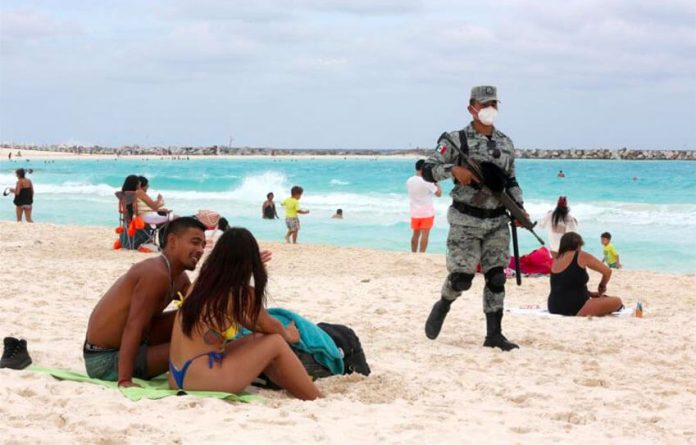Fifty years ago, the Mexican island of Cancún was home to a small fishing village and deserted beaches. Now it is one of the most visited holiday destinations in Latin America, its shores packed with hundreds of sunbathers, kids playing in the white sand and young tourists looking to party.
After being pummelled during the most intense periods of the pandemic, tourism has roared back. Almost 20 million passengers have passed through Cancún airport so far this year. Unlike most rival destinations, in September, October and November it had more visitors than in the same months in 2019, and hotel occupancy of 57% is better than the Caribbean, Hawaii or Bali, according to STR, a hospitality data and analytics company.
On top of year-round sun and a cheap trip for those with dollars, it has been helped by its proximity to the U.S. — whose citizens have driven the recent boom — and the fact that Mexico never closed its borders during the pandemic. It is still one of the few countries that does not require a COVID test for entry.
“It’s completely atypical in the context of the pandemic,” said Francisco Madrid, director of the Center of Research and Tourism Competitiveness at Anáhuac University in Mexico City. “Any country, any tourist destination would love to have the results that . . . Mexico’s beaches have.”
But the resort town and its surrounding area have also made headlines recently for the wrong reasons, as several violent incidents have burst the tourist bubble.
Last month gunmen stormed the beach of the Hyatt Ziva just east of Cancún, in the heart of the hotel zone, and opened fire and killed alleged rival drug dealers, sending tourists fleeing for shelter. Just weeks earlier two tourists were killed at a restaurant in Tulum, about 130 kilometers south of Cancún, in the crossfire of a shootout between alleged rival gangs.
On Tuesday morning men on jet skis opened fire at a beach outside a Cancún hotel. No one was hurt, authorities said.
Even amid Mexico’s high homicide rate, Quintana Roo, where Cancún is located, stands out. Homicide rates are at 28 people per 100,000 so far this year in the southeastern Mexican state, versus the national average of 18.5 per 100,000.
The Quintana Roo governor has said that two of the country’s largest drug groups, the Jalisco New Generation Cartel and the Sinaloa Cartel, operate in the state, attracted by the large market.
Hotel leaders in the region issued a blistering statement last month, blaming the recent violent incidents on ferocious, ruthless fighting between gangs seeking to sell and distribute drugs in the area.
“With enormous astonishment, sadness and absolute dismay, we see violence continues to escalate,” the HotelAssociation of Cancún, Puerto Morelos and Isla Mujeres said. “Tourism and the economic recovery are hanging by a thread.”
VIDEO | Elementos del Batallón de Guardia Nacional, especializado en funciones de Seguridad Turística en Quintana Roo, recorrieron esta mañana las principales playas de la zona hotelera de Cancún y algunos puntos estratégicos, con el supuesto objetivo de inhibir la delincuencia pic.twitter.com/8uiNQeudQG
— Noticaribe (@Noticaribe) December 2, 2021
In response, the federal government started a new tourist security battalion in the state last week with more than 1,400 National Guard troops.
“We’re going to beef up security, the presence of national security in the municipalities of Quintana Roo . . . People have died, Mexican and foreign, and that can’t happen again,” President López Obrador said in November.
“My mum was the one who made me conscious about it,” said Sharif LaPalma, a dual Argentine-U.S. citizen, on vacation with high school friends on the beach in Puerto Morelos, just south of Cancún. “The fact of seeing . . . army people in the streets makes you realize ‘OK something is going on here’, but we haven’t experienced anything.”
Although tourist areas are usually very safe, almost 85% of residents in Cancún report feeling unsafe in the city, much higher than most cities in the country, according to a survey by the government statistics body INEGI.
Extortion is also a big problem for local businesses, though it is not discussed openly. One shopkeeper near the beach said criminals had called for extortion payments a few times but they had just hung up and managed to keep them at bay for now.
“When they come and extort me, I’ll close,” said the person, who declined to give a name for fear of reprisals.
Despite the deteriorating security environment, tourists know that if they stick to the hotel zone, they will most likely be fine.
“Where we come from it’s worse . . . there’s no comparison,” said Héctor, a tourist from Monterrey. “All the tourists I’ve met don’t leave the hotel zone . . . They know it’s dangerous.”
© 2021 The Financial Times Ltd. All rights reserved. Please do not copy and paste FT articles and redistribute by email or post to the web.
